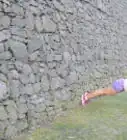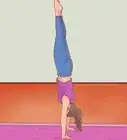This article was co-authored by Rosalind Lutsky, a trusted member of wikiHow's volunteer community. Rosalind Lutsky worked as a gymnastics coach at SB Gymnastics at Stanford University, coaching children from ages 5-12 years old during her time as a Stanford student. She was a competitive gymnast growing up, and competed for her local gymnastics team in Minnesota.
There are 10 references cited in this article, which can be found at the bottom of the page.
This article has been viewed 306,185 times.
Learn more...
Headstands are good fun and require less gymnastic skill and flexibility than other stunts such as back tumbles, back flips or walking on your hands. While headstands are sometimes used in meditative practices, they can also a fun party trick. If you are new to headstands, there are a couple easy methods to try lifting yourself into one.
Steps
Tucking into a Headstand
-
1Position your cushioned mat. You can use either a yoga mat or a gymnastics mat, but you want a mat that is going to provide some support to your head and neck and necessary cushion for comfort. Lay your mat lengthwise in front of you.[1]
- If you are a complete beginner to doing headstands, you can place your mat up against the base of a wall and practice your headstand with the support of the wall.[2]
- Practicing your headstand against a wall will help you figure out the different areas in your body that you need to flex and balance to hold a headstand.[3]
-
2Position your body like a table top. Kneel onto your mat. Bring your hands down in front of you onto the mat, so you are resting on your knees and hands. Your should now look like a table top.
- You hands should be lined up with your shoulders, and your knees should be lined up with your hips.[4] Bend and bring your elbows to rest down on the mat.
Advertisement -
3Lace your fingers and place your head. With your elbows on the mat distanced shoulder-width apart, clasp your hands together and lace your fingers together.[5] Extend your thumbs up toward the ceiling. Your hands and elbows should form a triangle shape that’s approximately 5 inches (12.7 cm) away from the base of the wall.[6] Tuck your chin downward, and bring the crown of your head down to the mat. Rest the back of your head in your palms, as your crown rests on the mat.[7]
- Change your head positioning as necessary until you find a comfortable position. You should always aim to rest on your crown, with your hands supporting the back of your head so you don’t strain your neck.
-
4Lift your knees to balance on your feet. Lift up your knees to straighten out your legs. Your buttocks should be in the air, and your body should look like an upside down ‘V’.[8]
-
5Bring your feet up the mat. You can use your core muscles to drag your feet up toward the rest of your body, or slowly walk up the mat.[9] [10] As you walk, your buttocks and hips will start to align with your back as you straighten out your core but stay bent at the hips.
- This movement will lift your shoulders over your ears as your spine aligns straight.[11] Keep your wrists, hands, forearms, and elbows strong and rooted into the mat.[12]
- You might feel like you are going to fall over like you would in a somersault. However, if you are practicing against a wall, the wall will support you and help you gain control so you can find balance.
-
6Lift your legs. Bring your knees close to your armpits. You should be on your tippy toes at this point.[13] Tighten your core and release your toes from the mat. Bring your bent knees into your chest, and use your core muscles to slowly try and raise your knees and extend your legs straight up out of the tuck.[14]EXPERT TIPRosalind Lutsky worked as a gymnastics coach at SB Gymnastics at Stanford University, coaching children from ages 5-12 years old during her time as a Stanford student. She was a competitive gymnast growing up, and competed for her local gymnastics team in Minnesota.Former Gymnastics Coach

 Rosalind Lutsky
Rosalind Lutsky
Former Gymnastics CoachRosalind Lutsky, former gymnastics coach, adds: “If you feel yourself falling forward, you should tuck your head in (chin towards your chest) so that you can safely roll out of the headstand, as if you were doing a somersault.”
-
7Come down from the headstand. Hold the headstand for as long as you comfortably can.[17] When you are ready to release the headstand, bend at your knees and bring both of your legs down, back to a tucked position in front of your chest.[18]
- From here, touch both of your toes back onto your mat, slide your feet back, and transition into a stretch also known as a “child’s pose.”[19] Shift your buttocks over the heels of your feet, and extend your arms straight out in front of you while keeping your hands on the floor.[20]
- Hold this stretch for at least a minute so your body can slowly adjust its blood flow.
- Consider doing a few neck rolls in different directions to relieve any tension in your neck.[21]
Kicking into a Headstand
-
1Position your cushioned mat. You can use a yoga mat or a gymnastics mat; either way, you want a mat that is going to give your support and cushion while you attempt your headstand. Lay your yoga or gymnastic mat lengthwise in front of you.[22]
- If you are not confident enough to practice your headstand freely, you can place your mat up against the base of a wall.[23] Anyone who has never attempted a headstand should first practice against a wall.
- Practicing against a wall will help you find the initial balance and strength needed to hold a free form headstand.
-
2Position your body like a table top. Kneel onto your mat. Bring your upper body down to the mat so your hands are out in front of you. Your body should now look like a table, with your knees lined up with your hips and your hands about shoulder-width apart.[24] Bring your elbows down to rest on the mat.
-
3Lace your fingers and place your head. With your elbows already on the mat shoulder-width apart, bring your hands together and lace your fingers.[25] Your thumbs should be extended upward, toward the ceiling. Your hands and elbows should look like a little triangle placed approximately 5 inches (12.7 cm) away from the wall.[26] Tuck your chin and bring your head down to the mat. Rest the back of your head in your palms, while the crown of your head should be contacting the floor.[27]
- Adjust your head positioning until you find comfort and stability. You don’t want to put too much strain on your head and neck by having your forehead resting on the mat.
-
4Lift your knees to balance on your feet. Tuck your toes, so your toes and maybe even the balls of your feet are making contact with the mat. Lift your knees up from the mat in order to straighten out your legs.[28]
- Your body should look like an upside down ‘V’.
-
5Walk your feet up the mat. Use your toes to slowly walk up the mat toward the rest of your body.[29] As you walk, your buttocks will start to lift and align with your back. This will straighten out your spine and lift your shoulders over your ears.[30] Keep your wrists, hands, forearms, and elbows strong and rooted into the mat.[31]
- You will start to feel less weight from your legs as you walk up toward your body. This is where tight core muscles come in. Your core muscles are going to lift your legs up and hold your body in the headstand position.
-
6Lift your legs. When your body is aligned and your legs are feeling lighter, tighten your core muscles and slowly lift one of your legs.[32] As you lift one of your legs, keep the other one near the ground to first find balance. When your one leg is in the air, gently hop your other leg off the ground, trying to straighten out both legs as much as possible. This is going to require a lot of strength from your abdominal core muscles. Use your core to lift up your legs, and use your arms to support and stabilize your body.[33]
- Check your body alignment by saying your name. If you’re aligned, you should be able to say it clearly, how you normally speak. If you can’t speak like you normally do, you may not be aligned correctly, and should come out of the headstand.[34]
- If you are practicing against a wall, place your first lifted leg against the wall. As you find balance, lift your other leg up to meet your extended leg. The wall will give you support as you gain stability.
-
7Come down from the headstand. Hold the headstand for as long as what feels comfortable to you. This could mean holding the headstand for a couple seconds or a couple minutes.[35] When you are ready to come down, separate your feet and slowly shift your balance to bring one of your legs back down to the ground. When your foot contacts the floor (or is on the way down), bring your other leg down from the headstand pose and onto the floor.
- When you completely back on the mat with your head still resting between your hands, straighten out your arms shift your buttocks back to rest on top of your heels.
- Extend and stretch your upper body to relax and allow the blood in your body to circulate away from your head. In yoga, this is sometimes called a “child’s pose.”[36] Try and hold this for about a minute so your body can readjust and relax.
- Consider doing some soft neck rolls after performing a headstand.[37] This can help prevent stiffness and tension after performing a headstand.
- If you stand up too quickly after a headstand, you could experience lightheadedness, and even faint.[38]
Community Q&A
-
QuestionWhat if I can't balance myself?
 Community AnswerPractice with a balance: lean against a wall or piece of furniture, or have a friend hold you in place as a spotter. Work on your core strength until you can support yourself without something to lean against.
Community AnswerPractice with a balance: lean against a wall or piece of furniture, or have a friend hold you in place as a spotter. Work on your core strength until you can support yourself without something to lean against. -
QuestionDo I need much training to do a headstand?
 Riley NextCommunity AnswerNo. It is a pretty basic move. Yes, it will take time, but you do not need much training to do it.
Riley NextCommunity AnswerNo. It is a pretty basic move. Yes, it will take time, but you do not need much training to do it. -
QuestionI keep losing balance. By the time my second foot goes up, my first one is coming down. Any tips to avoid that?
 Community AnswerDon't move your head; keep it still. Get good balance from keeping your hands steady on the floor.
Community AnswerDon't move your head; keep it still. Get good balance from keeping your hands steady on the floor.
Warnings
- If you have never attempted a headstand or any other sort of gymnastics, have a 'spotter' with you when you are doing this. Get a buddy to stand in front of you so you don't fall onto your back.⧼thumbs_response⧽
- Keep your neck straight. If it starts to hurt, stop!⧼thumbs_response⧽
- Make sure your practice area is clear of any obstacles.⧼thumbs_response⧽
References
- ↑ http://www.epyogaeugene.com/yoga-headstand-for-beginners/
- ↑ https://www.youtube.com/watch?v=7VTuYac3rKI
- ↑ http://www.organicauthority.com/how-to-do-a-headstand-what-your-yoga-teacher-isnt-telling-you/
- ↑ http://www.buzzfeed.com/shannonrosenberg/teach-yourself-to-do-a-headstand-in-5-moves#.ytqm89oNxl
- ↑ http://www.buzzfeed.com/shannonrosenberg/teach-yourself-to-do-a-headstand-in-5-moves#.ytqm89oNxl
- ↑ http://www.doyouyoga.com/a-beginners-guide-to-headstands-14010/
- ↑ http://www.epyogaeugene.com/yoga-headstand-for-beginners/
- ↑ http://gymnasticswod.com/content/tripod-tuck-headstand
- ↑ http://gymnasticswod.com/content/tripod-tuck-headstand
- ↑ https://www.youtube.com/watch?v=7VTuYac3rKI
- ↑ http://www.buzzfeed.com/shannonrosenberg/teach-yourself-to-do-a-headstand-in-5-moves#.ytqm89oNxl
- ↑ http://www.buzzfeed.com/shannonrosenberg/teach-yourself-to-do-a-headstand-in-5-moves#.ytqm89oNxl
- ↑ http://www.doyouyoga.com/a-beginners-guide-to-headstands-14010/
- ↑ http://gymnasticswod.com/content/tripod-tuck-headstand
- ↑ http://www.doyouyoga.com/a-beginners-guide-to-headstands-14010/
- ↑ http://www.epyogaeugene.com/yoga-headstand-for-beginners/
- ↑ http://www.organicauthority.com/how-to-do-a-headstand-what-your-yoga-teacher-isnt-telling-you/
- ↑ http://gymnasticswod.com/content/tripod-tuck-headstand
- ↑ http://www.yogajournal.com/article/inversions/ask-expert-try-headstand-inversions-first-time/
- ↑ http://www.epyogaeugene.com/yoga-headstand-for-beginners/
- ↑ http://www.epyogaeugene.com/yoga-headstand-for-beginners/
- ↑ http://www.epyogaeugene.com/yoga-headstand-for-beginners/
- ↑ https://www.youtube.com/watch?v=7VTuYac3rKI
- ↑ http://www.buzzfeed.com/shannonrosenberg/teach-yourself-to-do-a-headstand-in-5-moves#.ytqm89oNxl
- ↑ http://www.buzzfeed.com/shannonrosenberg/teach-yourself-to-do-a-headstand-in-5-moves#.ytqm89oNxl
- ↑ http://www.doyouyoga.com/a-beginners-guide-to-headstands-14010/
- ↑ http://www.epyogaeugene.com/yoga-headstand-for-beginners/
- ↑ https://www.youtube.com/watch?v=7VTuYac3rKI
- ↑ https://www.youtube.com/watch?v=7VTuYac3rKI
- ↑ http://www.buzzfeed.com/shannonrosenberg/teach-yourself-to-do-a-headstand-in-5-moves#.ytqm89oNxl
- ↑ http://www.buzzfeed.com/shannonrosenberg/teach-yourself-to-do-a-headstand-in-5-moves#.ytqm89oNxl
- ↑ http://www.organicauthority.com/how-to-do-a-headstand-what-your-yoga-teacher-isnt-telling-you/
- ↑ http://www.organicauthority.com/how-to-do-a-headstand-what-your-yoga-teacher-isnt-telling-you/
- ↑ http://www.organicauthority.com/how-to-do-a-headstand-what-your-yoga-teacher-isnt-telling-you/
- ↑ http://www.organicauthority.com/how-to-do-a-headstand-what-your-yoga-teacher-isnt-telling-you/
- ↑ http://www.organicauthority.com/how-to-do-a-headstand-what-your-yoga-teacher-isnt-telling-you/
- ↑ http://www.epyogaeugene.com/yoga-headstand-for-beginners/
- ↑ http://www.epyogaeugene.com/yoga-headstand-for-beginners/
- Videos provided by KinoYoga
About This Article
To do a handstand, start by positioning your body like a tabletop on a yoga mat or cushioned pad. Your hands should be palms down with your knees bent. Then, place your elbows on the floor and lace your fingers behind your head. Adjust if necessary to make sure your neck is comfortable so you won't strain your neck. Once you are comfortable, lift your knees to balance on your feet and walk forward, toward your torso. Finally, use your core to lift your feet off the ground and into the air. To learn how to kick into a headstand, scroll down!


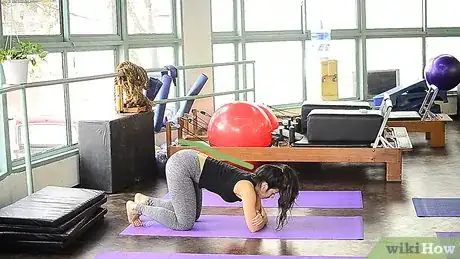
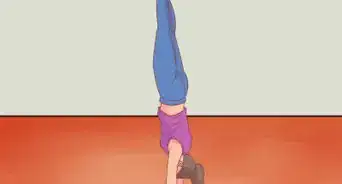
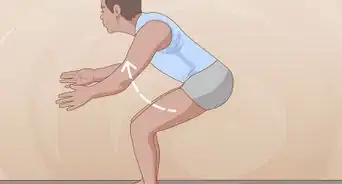



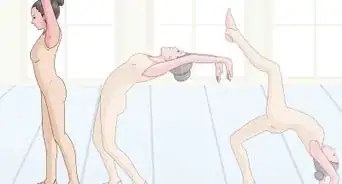

-Step-6-Version-4.webp)










